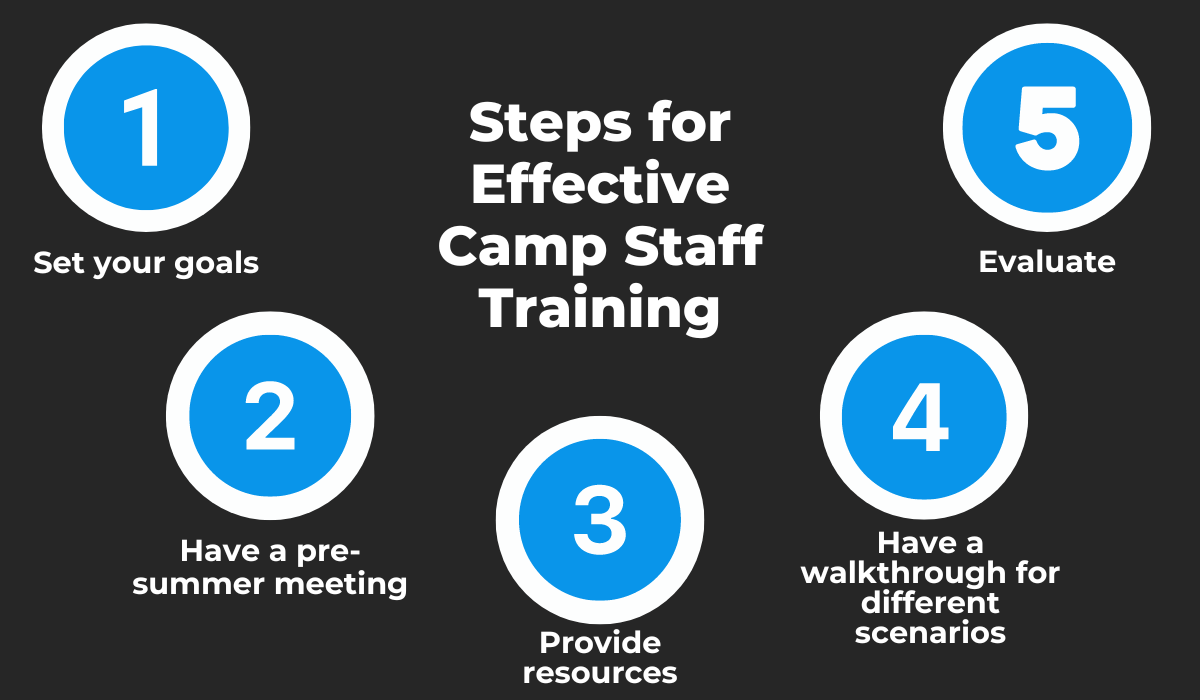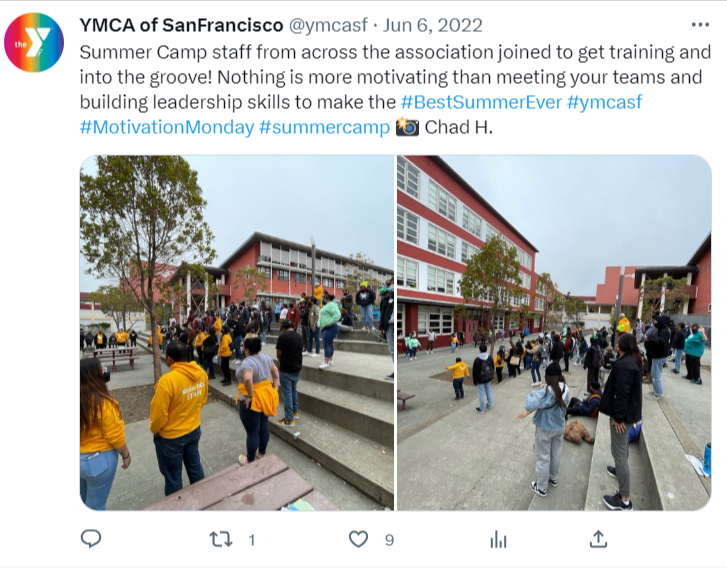Managing a summer camp is quite a challenge, no doubt about it.
In fact, it requires so much coordinating, planning, and analyzing, among plenty of other things, that it might be considered an art form in its own right.
To help out, we’ve compiled a list of the best camp management practices. Follow these, and you’ll improve and grow your camp in no time.
- Train Your Camp Staff Well
- Streamline Your Registration Process
- Automate Your Communications
- Ask For Feedback After Camp Ends
- Take Advantage of Collected Data
- Conclusion
Train Your Camp Staff Well
Your staff is the backbone and the face of your camp for its entire duration.
Finding the right people for the job is therefore crucial, but recruitment is just the beginning.
Without proper training, your team will be disorganized and unprepared for every eventuality that may befall them, from an unexpected downpour on the day they were planning to take the campers swimming, to a child handling homesickness poorly.
There’s a wide variety of ways you can approach it, but here are some essential steps you can take to create a staff training experience with the most successful outcome.

Data: Jotform/Illustration: Regpack
Before you even begin the training, it’s important to define its goals so you can successfully adjust the process to those objectives.
For example, you may want to focus on enhancing your relationship with your team for the sake of creating a safer space where all ideas are heard, or increasing camp safety by preparing staffers for different situations that might arise.
After you’ve set your goals, consider gathering your staff for a pre-summer meeting and use that time to allow them to get to know each other, to walk them through your camp’s values and program as well as the expectations you have for them.

Source: YMCA of SanFrancisco on Twitter
Don’t hesitate to include them in the conversation and allow them to express their own opinions.
This will deepen their emotional investment in the camp and increase their ownership over the camp’s success and achievements.
Moreover, don’t forget to provide your team with educational resources.
They can be provided in the form of a training manual (like in the example below), a website, or a training video. Whatever it is, make sure it contains all the relevant information.
Source: Camp Pinebrook
What constitutes relevant information is up to you, but some things you should consider including are camp values, its policies and other useful camp information, staff obligations, emergency procedures, etc.
During summer camp, a lot can happen, from serious situations like bullying or injuries to some less serious and everyday occurrences such as disagreements between campers or staffers.
But whatever happens, your team should be prepared. Therefore, walk them through different scenarios that might occur and teach them to diffuse a situation, should conflict arise.
Finally, make sure to take the time to evaluate your team. Take a look at what is being done well and what can be improved for each staff member.
All in all, your staff plays a crucial role in the campers’ experience.
Any lack of preparedness on their part could be detrimental to the camp’s success and therefore, recognizing the true value of proper training is the first step towards successful and effective camp management.
Streamline Your Registration Process
Another step you can take, as an efficient camp leader, is to look for ways to improve parents’ perception of your camp.
They are, after all, the ones who make the decision whether their child will enroll in your camp or not.
The registration process is a great way to make a positive first impression on parents as it sets the tone for the rest of the camping experience you’ll provide.
Therefore, looking into how you can streamline this part of the experience could mean a lot to them.
The fact is, parents don’t want to fill out long registration forms, and then waste time mailing them to you.
As a matter of fact, form length is a common cause of form abandonment, according to the Manifest, which means that a complex registration process has the potential to negatively impact your registration rates.
Source: The Manifest
A great solution for overly complicated registration forms is camp registration software. Just like the name suggests, software can take your camp registration process to another level.
Our own registration solution—Regpack—does exactly that, in many different ways.
To begin with, Regpack allows you to build your own registration forms and embed them on your website.
Source: Regpack
This way, you don’t have to redirect parents to another page for registration. It all happens on your own camp’s website. Plus, it can be done on any device.
Secondly, Regpack relies on conditional logic to guide the parents through the whole registration process, making them feel like you’re right there with them.
Source: Regpack
With conditional logic, you can set triggers that can activate particular questions.
For example, next to the question “Do you want to add another emergency contact?”, a parent can click either Yes or No.
If they click on Yes, the conditional logic activates a set of questions about that additional emergency contact, such as their first and last name, phone number, etc.
Moreover, parents need flexibility when it comes to payments, and Regpack offers exactly that, through integrated and secure payments, as well as different payment options.
Source: Regpack
Paying in full or in installments, with either a credit card, debit card, or mobile wallet—with Regpack, you can offer it all. And parents will surely appreciate it.
In conclusion, working towards streamlining your registration process is a must, and camp registration software can help you with this considerably, from registration forms that fit into your website seamlessly to integrated payments and versatile payment options.
Automate Your Communications
Efficient camp leaders know that having effective and personalized means of communication with parents is key to boosting your enrollment rates.
In order for your communications to get results, you should maintain them before, during, and after the camp, and the best way to do that is via email. It’s a great way to reach out to parents during each of those stages.
Source: Michelle Roy Iliescu on Twitter
Emails are versatile, cost-effective, personal, flexible, and can, with the help of camp registration software, be automated.
Although it might seem counterintuitive, automation improves the quality of communication. It saves you time and in turn, enables you to reach out to parents more often.
Let’s be honest, writing an email to every single parent confirming their registration, or thanking them for the experience after camp can be exhausting.
Camp registration software will help you with this, often tedious, task in a couple of ways.
Firstly, consider having to send invoices to the parents, for example.
For each invoice, you need to type in a different first name, last name, address, payment amount, child’s first and last name, etc. Typing in all of that information can eat up all your time.
With camp registration software, you can create only one email, type in whatever you want in the body of the email, and then add so-called tokens in places that vary from parent to parent, which will pull relevant information from their registration forms.
Source: Regpack
Later on, the emails can be edited if needed.
To continue, we’ve already covered triggers, which are part of the conditional logic feature, but did you know you can also use this feature to automate your emails?
You can easily do that by setting up certain conditions, i.e., triggers that cause an email to be sent.
For instance, you can set the action of completing the registration process to trigger an email with registration confirmation, along with some useful information, such as camp start dates.
In conclusion, while communication has an important role in your camp’s success, letting it take up all of your time is not necessary.
Instead, try allowing the technology to do the hard part so you can use your time more efficiently, without losing that important personal touch.
Ask For Feedback After Camp Ends
After camp is finished, don’t use that period to immediately start the marketing strategy planning for the next year, but instead, reflect on what you’ve learned from the latest experience.
Campers and their parents are valuable sources of information that can give you insight into what you’ve done well and into areas that might need some improvement.
After all, you do what you do for them, so their perception of your camp is what matters the most.
Now, collecting feedback is easier said than done. If you’re using paper evaluation forms, you already know that getting a response from parents is a rare occasion.
And who could blame them? Filling out long paper forms, as we already established in the first section, is a hustle.
Instead, go digital and try using camp registration software to create surveys that can be sent out via email.
When it comes to surveys, camp registration software can offer many features that make the evaluation process a breeze and the likelihood of parents submitting their forms much higher.
For example, look for software that saves parents’ answers in case they abandon the process before finishing it, so you still end up with at least some of the answers.
Adding the option to fill out the evaluation form anonymously is also a great bonus.
Source: Regpack
When it comes to the questions you should ask, make sure you cover a variety of question types.
Ease the parents and campers into it by including simple scale questions. This can either be a scale of 1-10 or an Agree-Neutral-Disagree scale.
Yes/no questions provide less information but there is still room for them in your survey.
Here are some examples of both:
Source: Regpack
Feel free to include some questions that require longer answers as well, but don’t go overboard.
The same rule applies to both paper and digital surveys: the quicker they’re completed, the better.
Finally, why not make positive feedback part of your marketing strategy and showcase some of it on your social media or the camp’s website?
Source: Young Greenwich on Twitter
After all, there’s no better advertisement than other campers’ positive testimonials.
Overall, asking for feedback is a great way to connect with parents and campers, show that you care about their experience but also to get some insightful data about ways your camp can be improved.
Take Advantage of Collected Data
Managing a camp requires a lot of short-term and long-term planning.
Relying on feedback helps significantly with that planning but there’s plenty of other data that can be crucial for your camp’s growth and improvement.
Source: American Camp Association
In other words, consider taking advantage of the data you have access to, collect it, track it, and analyze it.
It will tell you a lot about the current citation in your camp and also give you an idea of what areas might need some upgrades.
Information such as enrollment rates, camper retention rates, profitability, and staff turnover can be quite valuable and should not be overlooked.
You might say that tracking all that data seems like a lot of hard and tedious work. And you’d be right.
If you’re doing it manually, of course, and your data is scattered across different software or, even worse, different paper forms.
What you need to manage your data effectively is a centralized database that stores all the crucial information and can create custom reports to give you better insight into your camp’s current operations.
Camp registration software is exactly that.
Let’s take a look at the three most important reporting features that make this kind of software such a valuable asset when it comes to collecting and managing data.
Source: Regpack
First, having the ability to run reports from anywhere means that anyone on your team can access data wherever and whenever because the data is stored in the cloud, instead of on-premise servers.
Moreover, ideal software lets you track any type of data you’d like and enables you to compare it with any other set of data.
For example, you could compare last year’s enrollment rates against the ones from the year before.
Being able to generate statistics is another must-have feature. It enables you to better visualize the breakdown of any aspect of your camp’s operations.
To sum up, data collection is oftentimes overlooked by camp leaders as it is wrongfully perceived as time-consuming and unnecessary.
However, with the right software, analyzing data can provide you with invaluable insights that’ll enable you to make better-informed decisions in the long run.
Conclusion
Running a camp takes a lot of effort. However, with these five camp management practices we highlighted in the article, you’ll be more than equipped to take it to a whole new level.
Whether training new staff, collecting feedback from campers, analyzing data, or generally working towards improving the camping experience for everyone at your camp, you’ll find out that the more time you invest in maintaining these practices, the more they’ll pay off in the long run.

